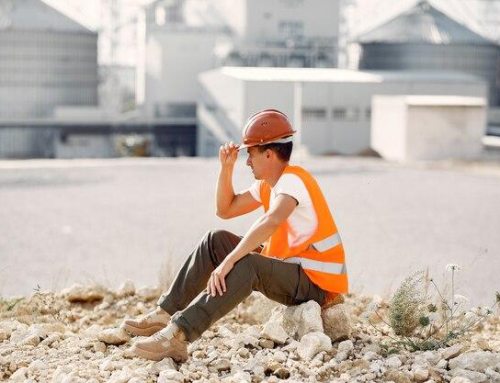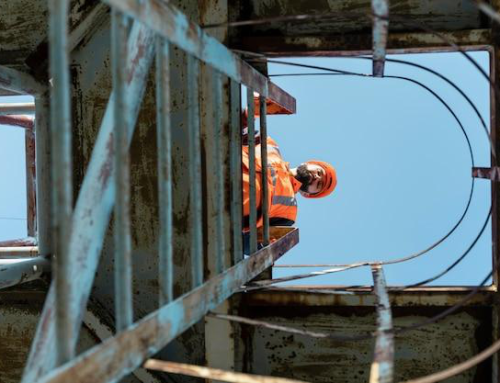British Columbia (BC) is no stranger to the impacts of climate change. With increasing temperatures and more frequent wildfires, the risks to worker safety are growing.
As the climate continues to change, it’s essential for BC workplaces to adapt and comply with safety regulations regarding extreme temperatures and air quality.
Let’s explore strategies for mitigating heat stress and wildfire smoke exposure, considerations for personal protective equipment (PPE), and the importance of worker training to address these climate-related hazards.
Understanding Climate Change Risks
Heat stress occurs when the body cannot cool itself sufficiently, leading to heat-related illnesses such as heat exhaustion and heat stroke. Factors contributing to heat stress include high temperatures, humidity, physical exertion, and inadequate hydration.
Wildfire smoke contains a mixture of gases and fine particles from burning vegetation and other materials. These particles can penetrate deep into the lungs and enter the bloodstream, causing respiratory and cardiovascular issues along with mental health issues.
Industries Most Affected by Climate Change
Workers in outdoor industries such as construction, agriculture, and forestry are particularly vulnerable, but indoor environments without adequate cooling can also pose risks.
1. Construction
Construction workers are highly susceptible to the dangers of extreme temperatures and wildfire smoke due to the nature of their work.
In 2023, BC experienced a record-breaking heat wave with temperatures reaching over 41.4°C in Lytton, which resulted in numerous heat-related illnesses and fatalities among outdoor workers . Not to mention the deadly 2021 heat wave, where 619 lives were lost across British Columbia.
Construction sites often lack sufficient shade and cooling systems, and workers frequently engage in strenuous physical activities, increasing their risk of heat stress.
Minimizing Risks with Training
Investing in Occupational First Aid (OFA) Levels 1, 2, and 3 training can drastically reduce these risks:
- OFA Level 1:Provides essential first aid skills, helping workers recognize early signs of heat stress and smoke inhalation, and administer initial care.
- OFA Level 2:Offers advanced training, including management of more severe cases of heat-related illnesses and respiratory issues, ensuring prompt and effective responses.
- OFA Level 3:Delivers comprehensive first aid training, equipping workers with the knowledge to handle complex medical emergencies, coordinate with emergency services, and perform life-saving interventions.
2. Agriculture
Agricultural workers are regularly exposed to extreme weather conditions.
The 2021 heat wave in BC led to numerous reports of heat exhaustion among workers, who spend long hours in direct sunlight without adequate shade or rest breaks .
The increasing frequency and intensity of wildfires also contribute to poor air quality, which can exacerbate respiratory conditions and lead to chronic health issues.
A study conducted in 2022 highlighted that heat mortality among farm workers is higher compared to workers across other industries, due to prolonged exposure and physical exertion .
Minimizing Risks with Training
OFA training can provide vital skills for mitigating these risks:
- OFA Level 1:Teaches basic first aid and emergency response, enabling workers to quickly address heat stress symptoms and minor respiratory issues.
- OFA Level 2:Offers deeper insights into managing severe heat stress and smoke inhalation, including the use of advanced first aid techniques and equipment.
- OFA Level 3:Equips workers with comprehensive emergency response skills, crucial for remote agricultural settings where medical help may be delayed.
3. Forestry
Forestry workers are directly impacted by wildfires, often working in high-risk areas during peak fire seasons.
Through 2021 to 2022, BC experienced one of its worst wildfire seasons, with over 1,600 fires burning approximately 869,279 hectares of land . This not only disrupts forestry operations but also exposes workers to intense heat and hazardous smoke.
The physical demands of forestry work, combined with extreme environmental conditions, significantly increase the risk of heat-related illnesses and respiratory problems.
Minimizing Risks with Training
OFA training is essential for forestry workers:
- OFA Level 1:Provides foundational first aid skills, crucial for immediate response to heat stress and minor injuries caused by smoke exposure.
- OFA Level 2:Focuses on advanced care, including managing more serious heat-related conditions and respiratory distress, essential for forestry environments.
- OFA Level 3:Offers in-depth training on handling severe medical emergencies, coordinating evacuation efforts, and performing life-saving procedures in remote locations.
4. Outdoor Maintenance
Workers in landscaping, road maintenance, and other outdoor maintenance roles frequently face prolonged exposure to extreme temperatures and poor air quality.
Outdoor maintenance workers often operate in urban settings, where heat islands can exacerbate temperature extremes, further increasing their risk of heat stress. Additionally, wildfire smoke can linger in urban areas, creating hazardous air quality conditions.
Minimizing Risks with Training
OFA training helps mitigate these risks:
- OFA Level 1:Equips workers with basic first aid skills to promptly address heat stress symptoms and minor respiratory issues.
- OFA Level 2:Provides advanced training for managing severe heat-related conditions and smoke inhalation, ensuring effective on-site care.
- OFA Level 3:Delivers comprehensive emergency response training, essential for handling complex medical emergencies and ensuring worker safety in high-risk environments.
Complying With Regulations – Extreme Temperatures & Air Quality
Workplaces must adhere to the Occupational Health and Safety Regulation (OHSR) set forth by WorkSafeBC. Key elements include:
- Heat Exposure Limits:Employers must ensure that workers are not exposed to temperatures exceeding the threshold limit values (TLVs) set by the American Conference of Governmental Industrial Hygienists (ACGIH).
- Monitoring and Assessment:Regular monitoring of workplace temperatures and heat indices is essential. Employers should assess the risk based on environmental conditions and the physical demands of the job.
- Engineering Controls:Implementing engineering controls such as air conditioning, ventilation, and shading can help reduce heat exposure.
- Monitor Air Quality:Regularly check the Air Quality Health Index (AQHI) and take appropriate actions when levels are high.
- Implement Controls:Use engineering controls like high-efficiency particulate air (HEPA) filters and enclose work areas to limit exposure to smoke.
- Provide PPE:Ensure that workers have access to appropriate respiratory protection, such as N95 masks, during periods of poor air quality.
Heat Stress & Wildfire Smoke Mitigation Strategies
- Hydration and Rest:Provide ample water and encourage frequent breaks in shaded or cool areas. Implement a work-rest cycle to prevent overheating.
- Acclimatization:Gradually increase workloads and exposure times for new or returning workers to build heat tolerance.
- Scheduling:Schedule strenuous tasks during cooler parts of the day, such as early morning or late evening.
- Indoor Workspaces:Whenever possible, move outdoor work to indoor environments with adequate air filtration.
- Rescheduling:Postpone non-essential outdoor tasks during periods of high smoke levels.
- Portable Air Cleaners:Use portable air cleaners with HEPA filters in work areas to reduce indoor smoke levels.
Using Personal Protective Equipment (PPE)
- Cooling Vests:These vests can help regulate body temperature by providing a cooling effect.
- Lightweight Clothing:Encourage the use of breathable, moisture-wicking fabrics to keep workers cool.
- Hats and Sunglasses:Provide wide-brimmed hats and UV-protective sunglasses to shield workers from direct sunlight.
- Respiratory Protection:Provide N95 masks or respirators to filter out harmful particulates from smoke.
r media
- Eye Protection:Use goggles or safety glasses to protect eyes from irritants in the smoke.
- Protective Clothing:Ensure workers wear long-sleeved shirts and pants to reduce skin exposure to particulates.
Importance of Workplace Safety Training
Training is crucial for ensuring that workers understand the risks associated with heat stress and wildfire smoke and know how to protect themselves. Comprehensive training programs should cover:
- Educate workers on the signs and symptoms of heat-related illnesses and smoke inhalation.
- Teach strategies for preventing heat stress and minimizing smoke exposure.
- Train workers on the appropriate actions to take in the event of a heat-related emergency or smoke inhalation incident.
As climate change continues to impact BC, workplaces must prioritize the health and safety of their workers by addressing the risks of heat stress and wildfire smoke.
Compliance with safety regulations, effective mitigation strategies, appropriate PPE, and comprehensive worker training are key components of a robust safety plan.
Prepare your workplace for the challenges of climate change with Metro Safety Training.
Our comprehensive safety and first aid training courses will equip your team with the knowledge and skills needed to handle extreme temperatures and poor air quality.
Whether you operate in construction, agriculture, forestry, or any other industry affected by climate change, Metro Safety is here to help. Contact us today to learn more about our OFA Levels 1,2, and 3 training in Surrey, Vancouver, and surrounding areas in BC!











